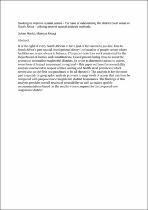 ResearchSpace
ResearchSpace
Seeking to improve spatial justice - the case of rationalising the district court areas in South Africa - utilising several spatial analysis methods.
JavaScript is disabled for your browser. Some features of this site may not work without it.
- ResearchSpace
- →
- Research Publications/Outputs
- →
- Conference Publications
- →
- View Item
| dc.contributor.author |
Maritz, Johan

|
|
| dc.contributor.author |
Moagi, M

|
|
| dc.date.accessioned | 2017-09-07T12:04:26Z | |
| dc.date.available | 2017-09-07T12:04:26Z | |
| dc.date.issued | 2015-08 | |
| dc.identifier.citation | Maritz, J and Moagi, M. 2015. Seeking to improve spatial justice - the case of rationalising the district court areas in South Africa - utilising several spatial analysis methods. Proceedings of the 27th International Cartographic Conference and 16th General Assembly, 23-28 August 2015, Rio De Janeiro, Brazil, 24pp. | en_US |
| dc.identifier.uri | http://www.icc2015.org/abstract,264.html | |
| dc.identifier.uri | http://hdl.handle.net/10204/9543 | |
| dc.description | Copyright: 2015. International Cartographic Conference (ICC). Due to copyright restrictions, the attached PDF file only contains the abstract of the full text item. For access to the full text item, kindly consult the publisher's website. | en_US |
| dc.description.abstract | It is the right of every South African to have just or fair access to justice. Due to South Africa’s past spatial development history the location of people versus where facilities are, is not always in balance. This paper describes work conducted for the Department of Justice and Constitutional Development during 2014 to assist the process to rationalise magisterial districts. In order to determine access to courts, some form of impact assessment is required – this paper outlines the accessibility analysis conducted in respect of the Gauteng and North West provinces (which served also as the first two provinces to be ad-dressed). The analysis is for the most part a spatial- or geographic analysis pro-cess to map levels of access that can then be compared with proposed new magisterial district boundaries. The findings of this analysis provides overall results of accessibility as well as makes specific recommendations based on the results when compared to the proposed new magisterial districts. | en_US |
| dc.language.iso | en | en_US |
| dc.publisher | International Cartographic Conference (ICC) | en_US |
| dc.relation.ispartofseries | Worklist;16470 | |
| dc.subject | Rationalisation | en_US |
| dc.subject | South African courts | en_US |
| dc.subject | Magisterial districts | en_US |
| dc.subject | Magisterial accessibility | en_US |
| dc.subject | Spatial analysis | en_US |
| dc.title | Seeking to improve spatial justice - the case of rationalising the district court areas in South Africa - utilising several spatial analysis methods. | en_US |
| dc.type | Conference Presentation | en_US |
| dc.identifier.apacitation | Maritz, J., & Moagi, M. (2015). Seeking to improve spatial justice - the case of rationalising the district court areas in South Africa - utilising several spatial analysis methods. International Cartographic Conference (ICC). http://hdl.handle.net/10204/9543 | en_ZA |
| dc.identifier.chicagocitation | Maritz, Johan, and M Moagi. "Seeking to improve spatial justice - the case of rationalising the district court areas in South Africa - utilising several spatial analysis methods." (2015): http://hdl.handle.net/10204/9543 | en_ZA |
| dc.identifier.vancouvercitation | Maritz J, Moagi M, Seeking to improve spatial justice - the case of rationalising the district court areas in South Africa - utilising several spatial analysis methods; International Cartographic Conference (ICC); 2015. http://hdl.handle.net/10204/9543 . | en_ZA |
| dc.identifier.ris | TY - Conference Presentation AU - Maritz, Johan AU - Moagi, M AB - It is the right of every South African to have just or fair access to justice. Due to South Africa’s past spatial development history the location of people versus where facilities are, is not always in balance. This paper describes work conducted for the Department of Justice and Constitutional Development during 2014 to assist the process to rationalise magisterial districts. In order to determine access to courts, some form of impact assessment is required – this paper outlines the accessibility analysis conducted in respect of the Gauteng and North West provinces (which served also as the first two provinces to be ad-dressed). The analysis is for the most part a spatial- or geographic analysis pro-cess to map levels of access that can then be compared with proposed new magisterial district boundaries. The findings of this analysis provides overall results of accessibility as well as makes specific recommendations based on the results when compared to the proposed new magisterial districts. DA - 2015-08 DB - ResearchSpace DP - CSIR KW - Rationalisation KW - South African courts KW - Magisterial districts KW - Magisterial accessibility KW - Spatial analysis LK - https://researchspace.csir.co.za PY - 2015 T1 - Seeking to improve spatial justice - the case of rationalising the district court areas in South Africa - utilising several spatial analysis methods TI - Seeking to improve spatial justice - the case of rationalising the district court areas in South Africa - utilising several spatial analysis methods UR - http://hdl.handle.net/10204/9543 ER - | en_ZA |





